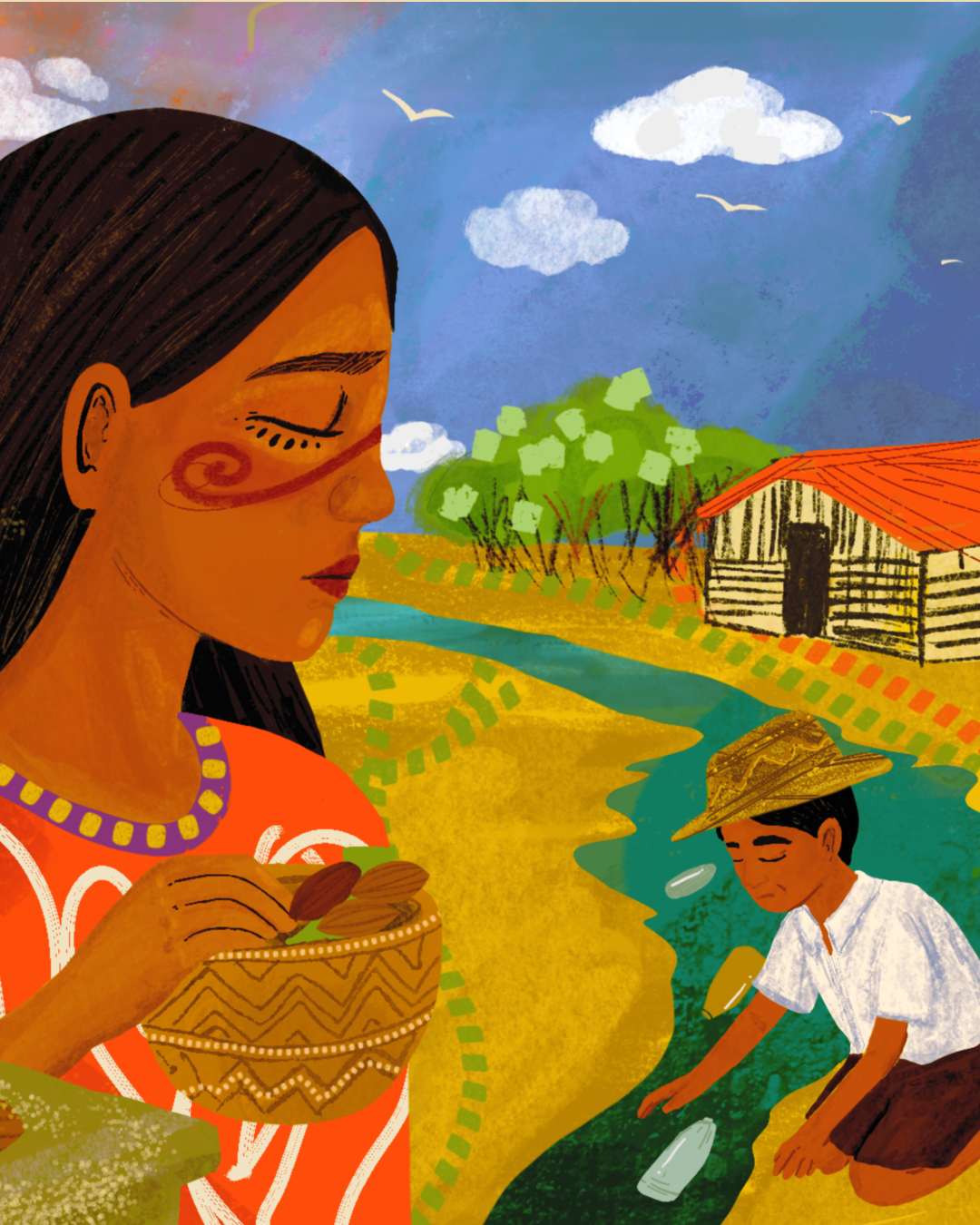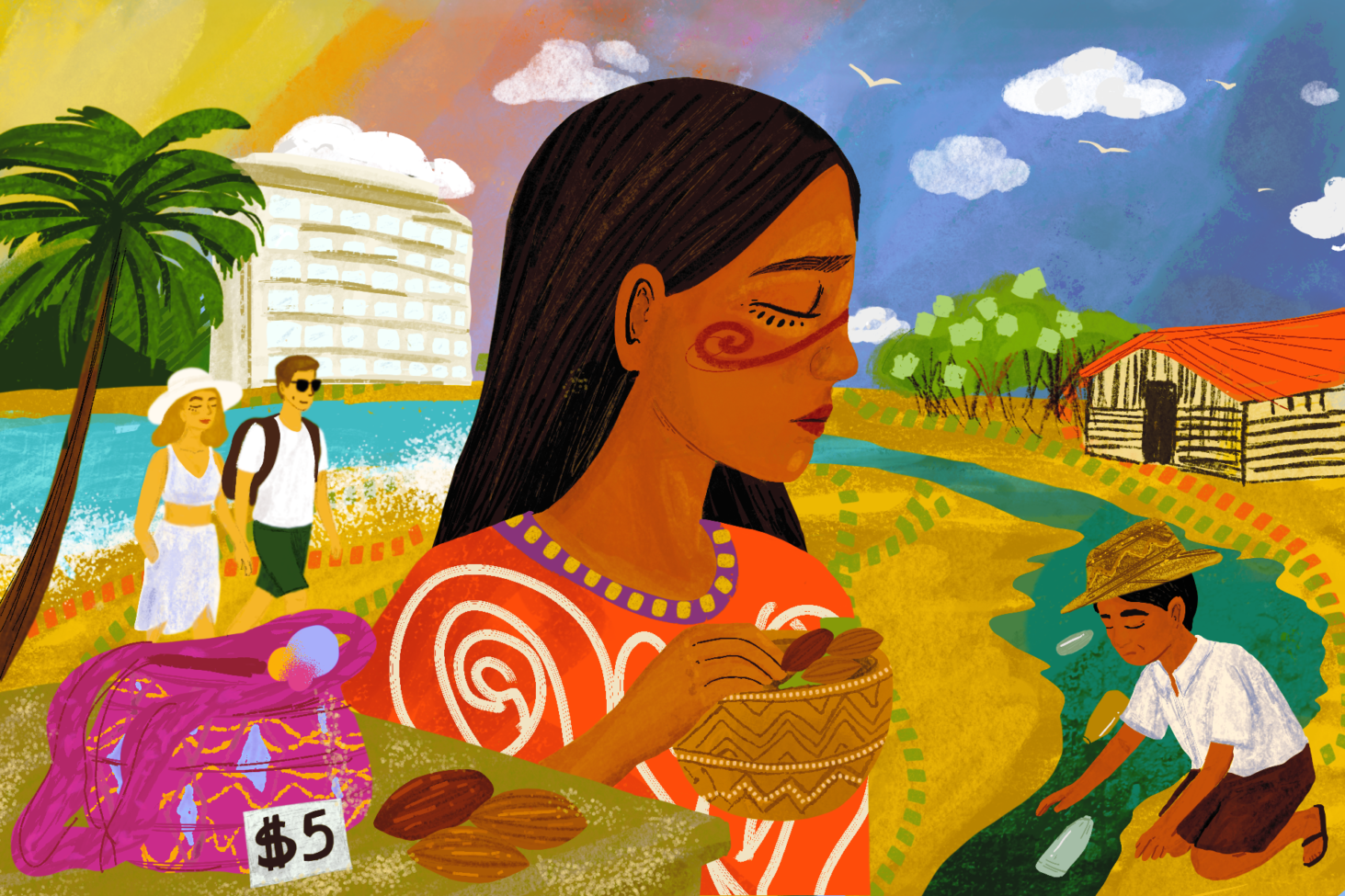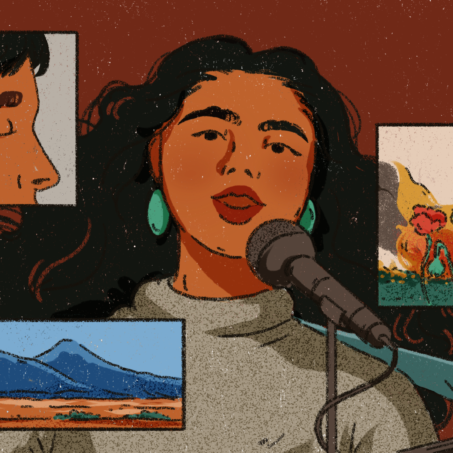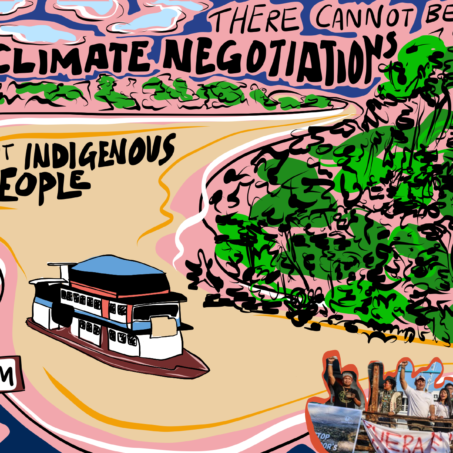One day in April, I found myself wandering the streets of Palomino, a well-known beachside town on Colombia’s Caribbean coast in the region of La Guajira. Though I am half Colombian, with my mother’s family rooted in the Santander region, it was my first time in this part of the country – and so, despite my ties, I walked its streets as a newcomer, seeing the place with a tourist’s eyes.
The first day I arrived, it was approaching 40 degrees, and sweat was clinging to me within two minutes of strolling out of my hostel. I found shade outside a trendy-looking, air-conditioned store that sold artisanal clothing, cacao grown in the region (repackaged and sold at high prices), and beautifully adorned Mochilas – a traditional Colombian woven bag created by local Indigenous communities.
The store was run by a German couple who had moved to the area just two years prior. Outside the shopfront, a local Indigenous Wayuu family sat on the pavement cross-legged, also selling handmade crafts and cacao grown in the south of the Sierra Nevada de Santa Marta, the world’s highest coastal mountain range, but for much cheaper.
The juxtaposition felt poignant, and I saw it a lot: new, modern, hip cafés, stores, hostels, and yoga studios owned by Westerners were dotted around the town, whereas locals selling artisanal gifts, offering tours of the area, and serving food, were confined to the street. I felt a broader sense of unease about my positionality, as a Westernised individual travelling to countries branded as ‘underdeveloped’, such as Colombia, with infrastructures that, over time, have become deeply catered to tourists like me.
The tourism boom
Tourism is a multi-trillion-dollar industry. Most countries have dedicated ministries or departments within their governments, with delegates in charge of regulating and managing tourism revenue.
In recent years, Colombia has grown as an international tourist hotspot, with 1.9 million visitors entering between January and May 2025 – a 6.6% increase from the same period the previous year. This boom in tourism over the last decade means Colombia is now centering tourism as a direction for new economic growth, and it’s quickly becoming an essential part of the country’s income.
However, the deep, synergistic workings of tourism have led to local and Indigenous communities globally becoming increasingly dependent on the industry, leaving them with little choice but to participate in its operations to earn a living.
Observing Palomino made me want to know what it was like for someone who had lived here for decades, watching tourism unravel their sense of belonging and alter their way of life on the land.
With the help of my mutual friend Guillermo, I spoke to three Palomino locals who had been living and working in the town for generations to learn about their experiences. We spoke in Spanish; what follows is my translation of their words.
The first person we talked to was Sergio, a 42-year-old native of Palomino who has lived in this town since birth. Before the tourism boom, he used to farm cattle, but since the influx of travellers, he now works as a tour guide. “I have an agency and I have now found benefits from tourism,” he tells me. “It’s a business that I didn’t imagine I would do, but it has changed everything, because I have more money and income, my life is better now because I can afford more.”
Jose, a 48-year-old man who also works as a tour guide in Palomino, felt similarly. “If I have to highlight something positive, the impact has been that we have more employment and a better quality of life. But,” he says, “there have also been negatives.”
He explains how, before the tourism boom, there were fewer tienditas (corner shops). “Now I feel like I can’t walk more than 20 metres without a tiendita selling things to tourists – it’s because our way of life has had to change to cater to them.”
These tienditas, often selling basic groceries, cigarettes and alcohol, have popped up as a response to the rise in the town’s footfall. The changing landscape means old sources of income, like working the land, are no longer sustainable – so locals are having to find other ways to make a living. As I meander down the streets, I notice the way tiendita assistants compete to get tourist sales and attention. I wonder, on a deeper level, how this need for competition against each other may have impacted the deeper sense of community in the town.
Spiritual tourism
I was unsure how many other tourists had stopped to take note of how their presence may affect locals, even though Palomino feels like a festival town overrun by visitors. Its economy is sustained by the thousands of visitors who come to the town, many of whom seek spiritual refuge and an escape.
One evening, in my hostel, I met an American woman who had made the move here five years ago. I asked her why she had decided to move from Seattle to this tiny coastal town in Colombia. “Things are a lot cheaper here than in the USA, and I wanted to move somewhere to become more spiritually in touch with myself,” she tells me honestly.
During my time in Palomino, I was invited to multiple yagé (the term often used for ayahuasca in Colombia) ceremonies, breathwork journeys, and yoga classes in modern shalas. Many of these, despite being advertised as ancestral or shamanic, were run by Westerners, for Westerners, at high prices. Palomino has become a place where people seek so-called transformational experiences – a growing market of “spiritual tourism.” Several travellers I spoke with, like the woman in the hostel, cited spirituality as their main reason for coming here.
Yet I couldn’t help but feel that the authenticity and sacredness of these practices were being diluted through their commodification. This is especially true for offerings such as Yagé – a plant medicine traditionally associated with Indigenous Amazonian communities – which are often presented as if they were local Indigenous practices. I noticed a troubling trend of homogenising Indigenous spiritual traditions, flattening the rich diversity of practices across different communities. Rituals once rooted in communal, intergenerational practice are re-framed as purchasable experiences, often detached from their genuine cultural context.
This raised an unsettling question for me: when spirituality becomes a product, who truly benefits? Locals may gain income, but often on terms set by foreign operators. Meanwhile, the deeper cultural context risks being erased, leaving behind an aesthetic of “authenticity” that is packaged and sold to those passing through.
A struggle of survival amidst rising prices
I also speak to 32-year-old Leonilda, an Indigenous Arahuac woman who makes her living by selling carefully handcrafted items. As we talk, she weaves a beautiful basket made from raw fleece that had been hand-spun into yarn. She tells me that each bag takes her between one and two months to complete, but on average, she sells each one for approximately $160,000 (£30).
“The costs are so, so high,” she laments. “We are being forced to pay the same prices as tourists, but we are not tourists. We do not have the money to pay $11,000 (£2) for a litre of oil. And yes, tourists want to continue buying the things we grow, but they want to buy them at very low prices. They don’t understand that we are struggling to buy things ourselves; it can be challenging.”
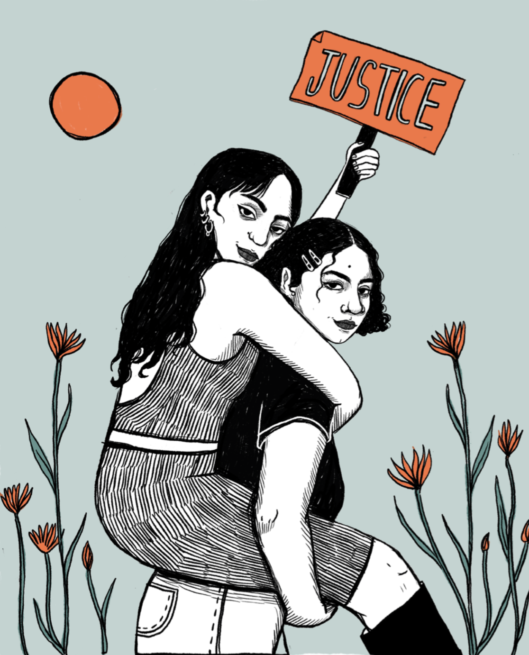
Join our mailing list
Sign up for shado's picks of the week! Dropping in your inbox every Friday, we share news from inside shado + out, plus job listings, event recommendations and actions ✊
Sign up for shado's picks of the week! Dropping in your inbox every Friday, we share news from inside shado + out, plus job listings, event recommendations and actions ✊
I recall visiting a cafe one morning on the main strip and ordering a latte which cost me the equivalent of £3 – an extortionate amount of money for a coffee in Colombia, let alone a tiny coastal town with a small population. Affordable hostels were everywhere, but so too were luxurious jungle cabins and opulent ‘paradise’ accommodations built to attract the wealthiest tourists, who continue to ramp up the town’s prices.
When paradise becomes a tourist attraction
As well as the increasingly inaccessible cost of living, locals are watching the quality of their land and terrain rapidly decrease. I imagined how easy access to the sea would have been just 10 years ago. Sergio tells me that ‘La Sexta’, the main road leading down to the popular beachfront, used to be jungle land inhabited by jaguars and other wild animals. Nowadays, most beach areas have been privatised and cordoned off. The jungle is nowhere to be seen, and hostels and hotels dominate the land.
“People bought the land on the beaches and by the rivers to make money,” Leonilda tells me. “The river is a sacred place, where we do our ceremonies. We used to do our work in the Sierra Nevada and go to the sea to do our ceremonies and pay our duties. But they have closed off the areas that are sacred for us, so we can no longer go to the land.”
La Sexta is also dotted with huts offering attractive deals to visit the jungle on tours into local Indigenous communities, each tourist company competitively trying to outprice the others. These ancestral territories, home to many Indigenous communities for centuries, are advertised as ‘untouched paradises’ – that is, until the seemingly inevitable clutch of the Western hand discovers it and pollutes it.
What was once a land sprawling with diverse wildlife is quickly becoming dilapidated and desolate. Jose tells me about the complicity of foreign visitors here. “Some tourists have really disrespected our land, there is rubbish everywhere on the beaches, in the rivers and in the sea. The air we breathe feels more contaminated because of the pollution from cars.” I noticed this, too; everywhere, from the beach to the river and forest, I visited during my time there, I found remnants of plastic bottles, bags, and food wrappings.
One afternoon, I saw a local family with two young children fishing litter out of the river. They said they felt they had to do it because otherwise, no one else would, and they would never be able to swim in the water again. They all spoke with pain about seeing their home disappearing like quicksand under their feet.
Can tourism truly be ethical?
In Palomino, I could see clearly how local communities have become constrained by the whims of Western tourists and depend on them to put food on the table and sustain their livelihoods. This commodification of local and Indigenous culture reflects Colombia’s colonial history, which seeps into the way tourists travel and come to reside on the land.
La Guajira continues to be one of the poorest regions of Colombia, alongside other areas in the country with a large Indigenous and Afro-Colombian population, a sadly unsurprising figure given the structural oppression faced by many Black and Indigenous populations across the world.
At the end of my seven days in Palomino, as I boarded the small, crowded bus that would take me to Santa Marta, the closest city two hours away, I pondered one question: Is ethical travel even possible? In a relatively short period, as I gazed out the bus window at the breathtaking views of my family’s homeland, I concluded that, truly, I don’t think decolonial travel can exist under global capitalism.
Borders, passports and trade are all interwoven with profound colonial legacies and structural violence. I hold three passports: Colombian, Lebanese and British. My family made it clear to me early on in my life that the first two passports were almost meaningless compared to the British one, whose authority dictates where I am allowed to move and who I am allowed to be.
My life as a Westernised second-generation immigrant has granted me access to a world of mobility that my family in Colombia and Lebanon will never experience. In the Western world, taking a gap year in Thailand and going on weekend European city breaks abroad have become normalised in the middle class. Mass tourism, despite being a relatively new industry, has become so normalised that many of us, even on the progressive left, neglect to reflect on the more troubling aspects of our desire to travel and explore the world.
The future of Palomino
I left with a persistent feeling of tension from the contradictions I experienced in La Guajira – how tourism brings in money yet erodes local cultures and environments. I think about how Sergio, Leonilda, and Jose all experienced these feelings too – and how it must feel to have your way of life change so rapidly without any control.
I fear that all potential ‘solutions’ hold complications while neoliberal capitalism remains the air we breathe and the land we walk on. I reflect on the fact that every local I spoke to, both those mentioned in this piece and those I talked to off record, highlighted the increased income as the only significant benefit they’ve experienced from tourism. And so, I can’t help but feel that the only thing we have truly helped to advance is a type of neo-colonial capitalism – something that they may now rely on financially, but never asked for.
The last question I ask Jose and Leonilda was how they envisioned Palomino in 10 years time. Their diametrically opposite, yet mutually devastating, answers have stayed with me. Jose, with a sting in his voice, says he expects it to be deserted, desolate without a beach, without rivers, without the beautiful mountains, and practically without water. Leonilda, in opposition, expects it will become a city, so built up that Palomino will no longer be recognisable as her homeland.
Between the fear of emptiness and the fear of overgrowth, Palomino’s future is already a warning – one symbolised by the sand, the river, and the jungle we are watching disappear. A solution is not straightforward, but perhaps listening to the voices of locals can begin to guide us toward forms of tourism that sustain, rather than erode, the places we love.
What can you do?
- Follow: this collective of Wayuu Indigenous women preserving indigenous culture in La Guajira
- Listen: The End of Tourism – a podcast about the histories and consequences of modern travel
-
-
- Listen: Shado-lite Season 2 Episode 3, Beach Access Movements and the island as a home
- Watch: Are You An Ethical Tourist? Great introductory video posing some ethical dilemmas of modern tourism
- Read: How holidaying in developing countries affects local inequality
-
